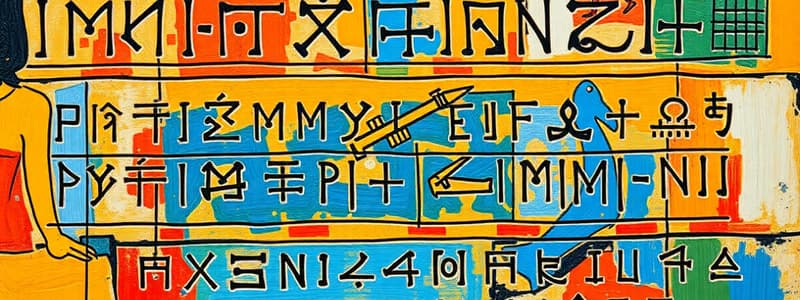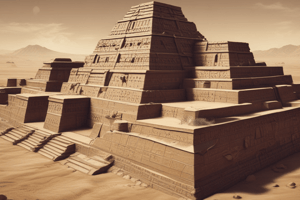Podcast
Questions and Answers
What trade system was primarily used by Mesopotamia for acquiring resources?
What trade system was primarily used by Mesopotamia for acquiring resources?
- Gift economy
- Bartering and eventual coinage (correct)
- State-controlled trading
- Currency exchange only
What is a notable feature of the Indus Valley civilization’s trade system?
What is a notable feature of the Indus Valley civilization’s trade system?
- Bartering was the only method of trade.
- Trading occurred only with neighboring villages.
- Evidence of standardized weights and measures. (correct)
- They used coins for all transactions.
Which writing system is associated with ancient Mesopotamia?
Which writing system is associated with ancient Mesopotamia?
- Hieroglyphics
- Phoenician alphabet
- Cuneiform (correct)
- Indus script
What is unique about the writing system of the Indus Valley civilization?
What is unique about the writing system of the Indus Valley civilization?
What describes the social structure of ancient Mesopotamia?
What describes the social structure of ancient Mesopotamia?
How did the social structure of the Indus Valley civilization compare to that of Mesopotamia?
How did the social structure of the Indus Valley civilization compare to that of Mesopotamia?
What was a central aspect of religious practices in Mesopotamia?
What was a central aspect of religious practices in Mesopotamia?
Which religious belief is suggested to be linked with the Indus Valley civilization?
Which religious belief is suggested to be linked with the Indus Valley civilization?
What agricultural innovation is prominently associated with Mesopotamian culture?
What agricultural innovation is prominently associated with Mesopotamian culture?
Which achievement is uniquely attributed to the Indus Valley civilization?
Which achievement is uniquely attributed to the Indus Valley civilization?
What is a significant philosophical contribution of ancient Chinese dynasties?
What is a significant philosophical contribution of ancient Chinese dynasties?
What was the primary purpose of the Egyptian pyramids?
What was the primary purpose of the Egyptian pyramids?
What was a common outcome of trade and economic activities in ancient civilizations?
What was a common outcome of trade and economic activities in ancient civilizations?
Which of the following advancements was NOT associated with ancient Mesopotamian civilization?
Which of the following advancements was NOT associated with ancient Mesopotamian civilization?
What feature of urban planning is most prominent in the Indus Valley civilization?
What feature of urban planning is most prominent in the Indus Valley civilization?
Which of the following materials was significant in the development of ancient Chinese civilization?
Which of the following materials was significant in the development of ancient Chinese civilization?
Flashcards
Mesopotamia's Significance
Mesopotamia's Significance
Mesopotamia, meaning 'land between the rivers,' was centered in the Tigris and Euphrates river valleys, fostering agriculture and dense populations.
Mesopotamian Trade
Mesopotamian Trade
Mesopotamia had extensive trade networks across the Fertile Crescent and beyond, using barter and eventually coinage.
Cuneiform Writing
Cuneiform Writing
Cuneiform, the earliest known writing, emerged in Mesopotamia around 3200 BCE, initially for record-keeping and later for complex ideas.
Indus Valley Civilization's Location
Indus Valley Civilization's Location
Signup and view all the flashcards
Indus Valley Trade Sophistication
Indus Valley Trade Sophistication
Signup and view all the flashcards
Undeciphered Indus Script
Undeciphered Indus Script
Signup and view all the flashcards
Indus Valley Social Hierarchy
Indus Valley Social Hierarchy
Signup and view all the flashcards
Mesopotamian Religious Practices
Mesopotamian Religious Practices
Signup and view all the flashcards
Code of Hammurabi
Code of Hammurabi
Signup and view all the flashcards
Cuneiform
Cuneiform
Signup and view all the flashcards
Ziggurat
Ziggurat
Signup and view all the flashcards
Ancient Chinese Philosophies
Ancient Chinese Philosophies
Signup and view all the flashcards
Indus Valley Planning
Indus Valley Planning
Signup and view all the flashcards
Ancient Trade Routes
Ancient Trade Routes
Signup and view all the flashcards
Ancient Egyptian God
Ancient Egyptian God
Signup and view all the flashcards
Egyptian Pyramids
Egyptian Pyramids
Signup and view all the flashcards
Study Notes
Ancient Mesopotamia
-
Mesopotamia, meaning "land between the rivers," encompassed the Tigris and Euphrates river valleys. Its fertile crescent facilitated agriculture and supported dense populations.
-
Early settlement around 3500 BCE, marked by the development of sophisticated societies.
-
Trade Systems: Mesopotamia engaged in trade networks extending across the Fertile Crescent, as well as further afield. Barter and eventually coinage were used. Trade was vital for acquiring resources like timber and metals.
-
Writing Systems: Cuneiform, the earliest known writing system, emerged in Mesopotamia around 3200 BCE. Initially used for record-keeping in commerce, it later evolved into a means of expressing complex ideas.
-
Social Structures: Mesopotamia was a hierarchical society, a complex political system with kings and powerful priests. Differentiated social classes emerged – ruling elite, priests, scribes, merchants, artisans, and farmers. Enslavement existed.
-
Religious Practices: Mesopotamian religion was polytheistic, with numerous gods and goddesses associated with natural forces and human activities. Elaborate temples (ziggurats) were built to honor these deities, and religious rituals and ceremonies were prevalent.
Indus Valley Civilization
-
The Indus Valley Civilization developed in the Indus River valley, modern-day Pakistan and Northwest India, around 3300 BCE.
-
Trade Systems: The Indus Valley traded extensively, evidenced by the discovery of standardized weights and measures. Trade routes extended to Mesopotamia and possibly beyond. Evidence suggests a sophisticated, well-organized system.
-
Writing Systems: The Indus script remains undeciphered. Although many symbols have been identified, their meaning and the language remain unknown.
-
Social Structures: Indus society exhibited advanced urban planning. Cities were remarkably well-structured, with sophisticated infrastructure (sewers, drainage systems). While differences existed, evidence suggests a less rigidly stratified social hierarchy compared to Mesopotamia.
-
Religious Practices: Religious practices of the Indus Valley remain partially understood. Evidence suggests a belief in religious figures and rituals, possibly connected to fertility and nature. Evidence suggests a possible system of worship of nature, with possible links to later Hindu beliefs. A unique cultural and artistic aesthetic exists, indicating a potential advanced ritual or symbolic expression.
Comparison: Mesopotamian and Indus Valley Civilizations
-
Both civilizations were advanced for their time, developing sophisticated agricultural practices, urban planning, and complex social structures. However, they exhibited differences in their writing systems, social hierarchies, and religious beliefs.
-
Mesopotamia, with its cuneiform writing system, offers a clearer picture of its societal details. Comparatively, the lack of deciphered Indus script hinders a full understanding of that civilization.
-
Both systems likely developed independently, though Mesopotamia and Indus had contact as indicated by trade goods.
Studying That Suits You
Use AI to generate personalized quizzes and flashcards to suit your learning preferences.




